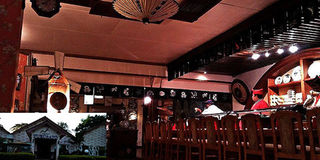OUT&ABOUT: Japanese cuisine in Nairobi

Furusato is a Japanese restaurant located in in Parklands. PHOTO| TOM MWIRARIA
What you need to know:
- My curiosity perked as I arrived at a place where a rich aroma wafted down and beckons you. The dining room was exquisite, with a warm ambience of orange lighting, and gripping murals from the Far East.
- For many centuries, meat eating was forbidden in Japan owing to the Buddhist tradition, and Shojin ryori. The traditional vegetarian meals served in Buddhist temples, considerably influenced the cuisine of the time.
- The basic manners while enjoying Japanese meal is disregarding the presentation of the food such as scouring through the ingredients to eat specific ingredients and leaving the rest of the food.
hI was on hunt for a Japanese restaurant in Nairobi, to experience the Jap cuisine culture that has unique place in the world.
Furusato restaurant in Parklands was immediately recommended by a friend who at the same time advised me that eating there would cost me an arm and leg and I would live like a pauper for a year.
AMBIENCE
My curiosity perked as I arrived at a place where a rich aroma wafted down and beckons you.
The dining room was exquisite, with a warm ambience of orange lighting, and gripping murals from the Far East.
Fabulous cream curtains were slightly opened to let in the scented evening air and allow a view of floral garden from the outdoor set-up.
Each table had a bloom of flower and the polished silver cutlery was methodically placed on the draped tables and shone brightly in the modest-warm light.

Interior decor of Furusato, Japanese Restaurant in Parklands. PHOTO| TOM MWIRARIA
At each place stood pearly ceramic ware and there were beautifully folded crimson napkins to match the runner.

Japanese salad with broth. PHOTO| TOM MWIRARIA
THE GUESTS AND CUISINE
The guests, mostly of Far East origin, were breezing in groups and couples. They settled in with animated chatter.
The servers, all young people dressed in white tunics move wordlessly to and from tables, keeping the platters and glasses full. Ocean creatures drizzled in sauces or begging to be dipped in spicy concoctions.

Chefs preparing Japanese cuisine. PHOTO| TOM MWIRARIA
I was still blown away by how much thought goes into the preparation, and appreciation of Japanese food.
A tall, smiley waiter stood stiffly in his starched white shirt and black bow-tie as I perused the menu and finally ordered Chicken Teriyaki.
Before the much awaited Teriyaki, a Japanese salad was brought. One characteristic of Japanese cuisine is its use of dashi broth prepared with ingredients including young corn, dried bonito flakes, kelp, or boiled and dried fish to produce umami, which gives the basic flavour of pungency, sweetness, saltiness and bitterness.

Japanese Salad with broth. PHOTO| TOM MWIRARIA
Japanese cuisine is regarded as one of the healthiest in the world. Meals comprise of a generous portion of vegetable based dishes and salad.
For many centuries, meat eating was forbidden in Japan owing to the Buddhist tradition, and Shojin ryori.
The traditional vegetarian meals served in Buddhist temples, considerably influenced the cuisine of the time.
The Buddhist influence is still evident in the modern Japanese food, with vegetables playing an important part everyday dining.
The concept of ichi ju san sai meaning “one soup and three side dishes”–miso soup and three vegetable side dishes–accompanied by rice and a main protein such as fish is regarded as a balanced diet by the Japanese.
At the heart of Japanese cooking is the principle of shun, using ingredients when they’re in season and as such at the peak of their freshness and flavour.
USING CHOPSTICKS
My sizzling hot chicken Teriyaki with rice and its broth was brought and arranged beautifully.
The arduous struggle of using chopsticks was witnessed at the restaurant as I held them like tongs.

Chicken Teriyaki. PHOTO| TOM MWIRARIA
It is said that how you hold chopsticks reveal how cultivated you are.
The proper way is holding the centre with right hand or holding them with the left hand and bringing the right hand towards the rear end.
The are major don'ts in the use of chopsticks. Some include: joining the two chopsticks together and using them like a spoon; using chopsticks to bring utensils closer towards oneself; grasping the two chopsticks together; transferring food from one set of chopsticks to another; pointing at the dishes with chopsticks while deciding what to eat; holding the chopsticks with one hand each and cutting the food like a knife and fork and lastly, picking away at food such as rice that is stuck on the chopsticks.
JAPANESE TEA
Japanese tea was revitalising and reinvigorating to the whole being.
Japanese tea is a beverage loved worldwide for its taste and medicinal value.
The country’s long history with tea goes back more than 1,000 years when tea drinking was first introduced to Japan from China by Buddhist monks.

Japanese tea. PHOTO| TOM MWIRARIA
Loved for its excellent flavour and benefits to health and wellbeing, tea soon became popular with court nobility and the samurai lifestyle. The tradition of the tea ceremony—called by various names such as chanoyu, chado, and sado—was formed.
TABLE MANNERS
Japanese dining etiquette is mostly about expressing gratitude to the hosts for providing the banquet.
The basic manners while enjoying Japanese meal is disregarding the presentation of the food such as scouring through the ingredients to eat specific ingredients and leaving the rest of the food.

The restaurant's outdoor setup. PHOTO| TOM MWIRARIA
Placing elbows on the food is frowned at and bringing your mouth to the serving dish.
Eating directly from the platter while food is being served on the latter is lack of etiquette.
PRICING

Animal statues at Furusato Japanese Restaurant. PHOTO| TOM MWIRARIA
The food was fairly priced ranging from Sh1200 to Sh2000. Despite what my friend said, I did not break a bank, nor my arm and leg.





